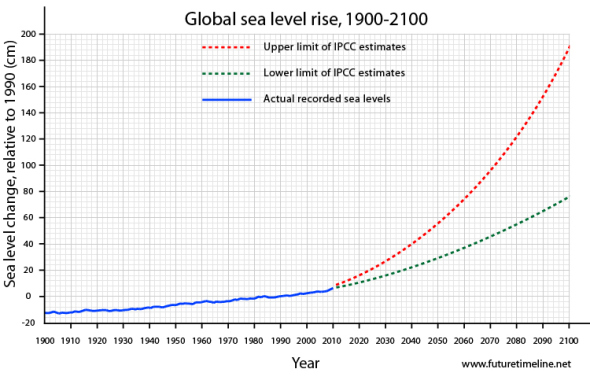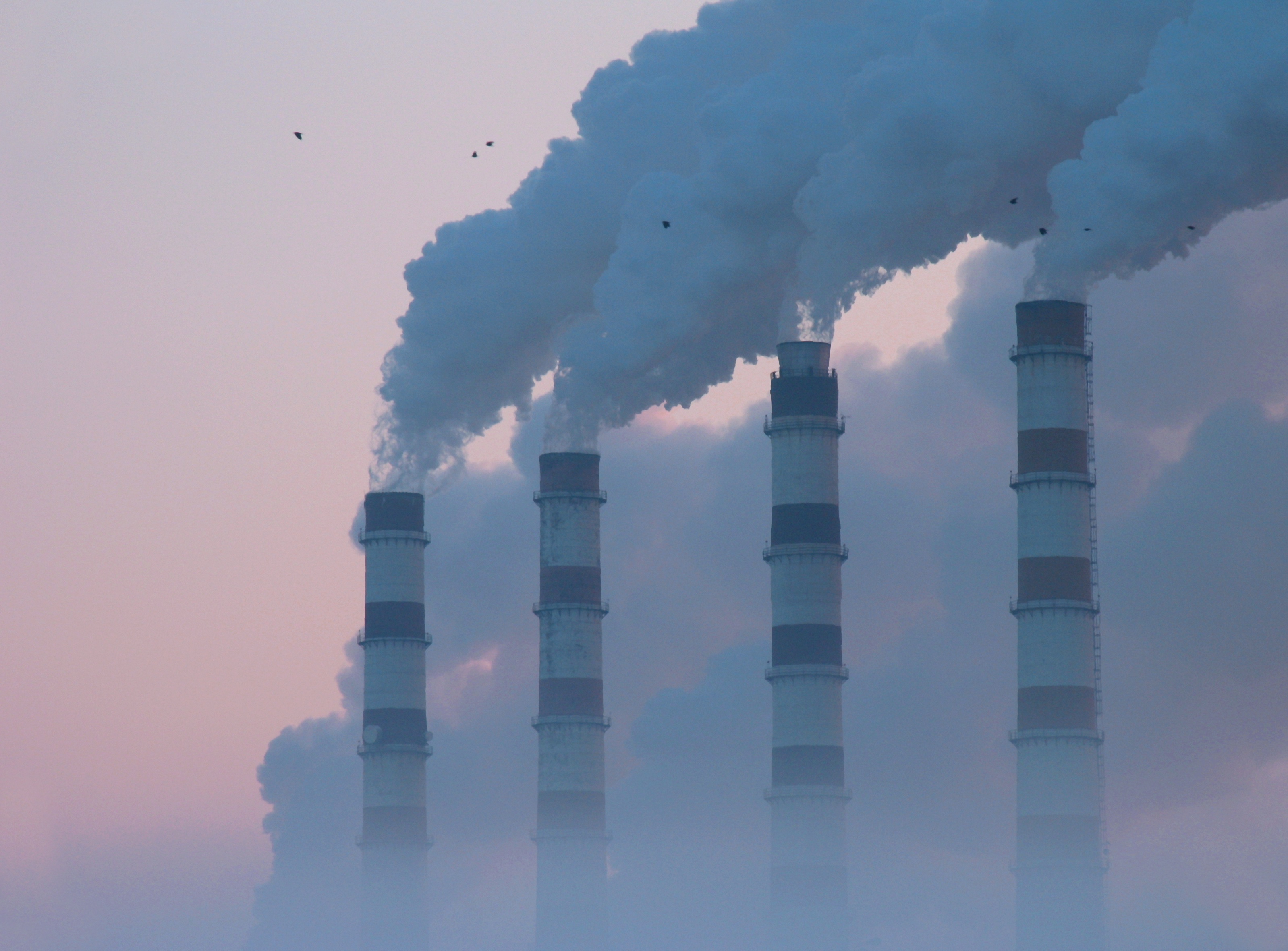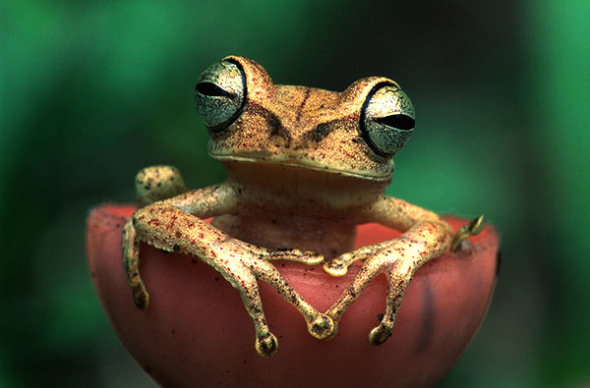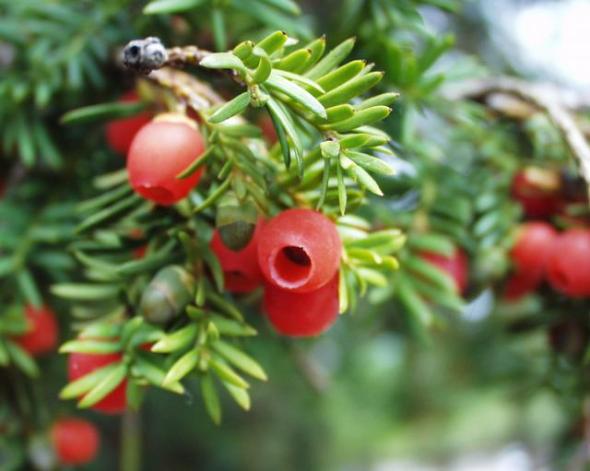Environmentalism chapter 5 - Tigers under threat
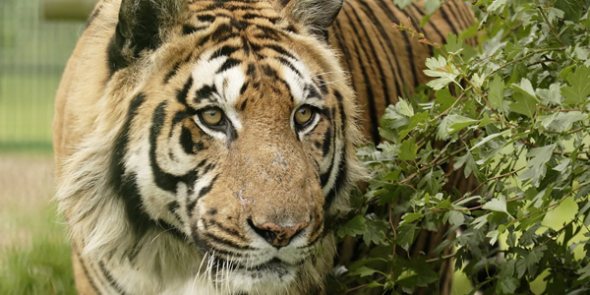
Bengal Tiger - Panthera tigris
The Tiger Panthera tigris the king of the jungle, a stunning species of “Tigers” that are now in serious need of preservation to keep it within the extant centuries to come and not the extinction era.
The Tiger species is the largest of all the big cat species standing at some 11-11.5 feet tall it’s regrettably the most endangered species out of all the wild cat species. Located mostly in east Asia, Russia, Turkey, Bali, India, it lives within large peat grass lands, dense forest and of course its natural areas in Asia where they are mostly located around and within the Ramin tree, (Gonystylus) areas of Indonesia and Malaysia although populated in India where poaching is rife.
With a total body length of just over three meters the Tiger species where wildly populated all over Asia, mainly in Indonesia, Malaysia, India, Japan, Russia and Belize however there numbers have plummeted to alarming levels. Now for 2013 they don’t even stand at 4,000
Bengals and Sumatrans are not the only species within the “Tigris” sub species that are at risk, the largest subspecies the Amur Siberian tiger Panthera tigris altaica is also critically endangered. There are roughly only 3,200 maximum Tigers left in the wild, that is a total in the last century gone of at least 98.5% of all Tiger species banished from the jungles of which they stalk their prey and rely mainly on sight and sound to hunt making them the most sleek predatory hunting cat that walks the earth. There declining numbers are primarily due to;
Tiger population decline;
- Habitual destruction
- Deforestation
- Palm oil and pulp and paper trade
- Human and species conflict
- Poaching
- Skin and fur trade
- Pollution
- Climate change
- Tropical pet trade
- Bone wine trade
- Snare and Traps

Sumatran tiger killed in an APP supplier’s concession inside the UNESCO Biosphere reserve’s buffer zone in September 2010 © WWF-Indonesia
Read more athttp://news.mongabay.com/2013/0110-dead-tigers-dead-people-sumatra.html#pDHT4oz1xagcoFmG.99
Asia Pulp and Paper we are working to shut down and hold accountable for their destruction of the Sumatran Tiger and Orangutan species. You can help by signing the petition simply by clicking the photo above to help us and other conservationists now take action against them and shut these criminals down. We don’t want to see more animals die as of over consumerism. We have the complaint and papers logged we just need the VOICES. PT KAL are also on our list, of which BOTH companies are listed on the RSPO and both have American owners.. Thanks “America for not caring”
One cannot just blame the poacher with regards to the copiously decreasing numbers of all Tigers although poaching is a contributor one must remember that “humans” that are not even living within the same continent’s as the Tiger species are also contributing to the callous destruction of the Tiger and it’s habitat due to obsessive over consumerism of paper, wood furnishings, to purchasing of foods that have “non-sustainable palm oil” within the product and “sustainable palm oil”.
The sustainable palm oil trade is nothing but a governmental and industrial lie that pushes you in to purchasing more “sustainable” products and “recyclable paper”. Does the industry explain to you though that purchasing of recyclable and sustainable goods is at an all-time high of such sustainable food, paper and wood products? No it lies to you or just stays silent.
With over obsessive consumerism being one of the massive problems why Tigers are savagely murdered everyday then unfortunately we will see the last of the Tigers wiped in one to two years because of this growing consumerism demand hence the quote “sustainable productivity lie” that environmentalists have tried to explain to you for many years now that’s killing the Orang-utans of too due to what you believe is “safe green living and purchasing”.
Excluding climate change vastly in chapter 5 it’s now down to all of us to cut our massive intake of goods and reuse more within the “home” instead of just sending goods to be recycled we now have to “reduce as much as we can” which in turn then decreases deforestation = less habitual destruction that keeps the Tiger species within its natural habitat thus decreasing human species conflict and lowered species birth rate of which the Tiger species normally gives birth to 3-5 cubs a year on average.
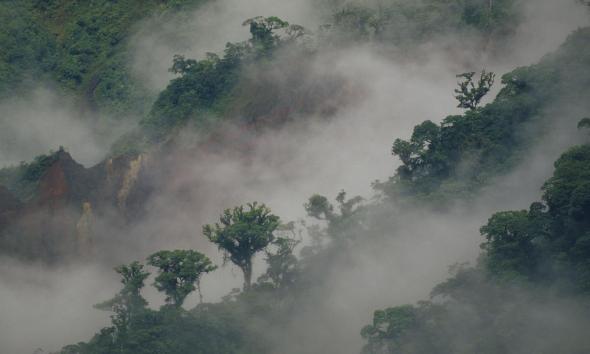
The Tiger species that’s mostly populated to Asia now lives in dense forestry and high grass lands pictured above. Sadly this is under threat with over twelve x football sized pitched sized forests felled a day the Tiger stands no chance. Human and species conflict is common because of this, regrettably the Tiger pays with it’s life which is a sad yet common fact of life that humans around the world are playing a part in with many not even knowing what their habits are causing..
Common knowledge now states the industry cannot keep up with the high demand for “recyclable products”, so to stay with the demand the logging industry then uses more “worked” land over again to non-worked agricultural land.
Commercialisation and massive want for more “recyclable goods” because we believe that we are doing the correct thing by purchasing only recyclable products has then the knock on effect as it would with the non-recyclable industry.
The three R’s is what we at International Animal Rescue Foundation © “promotes” wisely of which one cannot just practice one, and not the other two, by simply using the “recyclable” option and not concentrating on the other two most important factors then this will push the demand up equalling more deforestation. With illegal logging also on the increase then the circle of destruction spirals out of control.
Pollution is also a massive benefactor that is decreasing Tiger populations due to green land forest destruction that equals lowered birth rates, and eventual death. It’s been widely discussed now within our news journal and many other environmental columns that pollution is at a massive high which again is due to over commercialisation and demand. But how does pollution affect the Tiger species?
Air pollution does not only damage the air it also damages living environments on the Earth’s surface and their inhabitants. Plants and animals are harmed by air pollution. Sometimes it is the pollutants themselves that cause damage. Other times pollutants combine and change the resources that plants and animals depend upon such as water, soil, and nutrients. What types of pollutants are damaging this sector that the Tiger lives within though?
Air pollutants called chlorofluorocarbons (or CFCs) destroy ozone molecules in the stratosphere. This has left places in the layer where the ozone is thin. These areas of thin ozone are called ozone holes. The ozone layer, located in the stratosphere layer of Earth’s atmosphere, shields our planet from the Sun’s ultraviolet radiation.
Ultraviolet radiation causes skin cancer and damages plants and wildlife. In recent decades the number of CFCs released into the atmosphere has decreased significantly due to an agreement between the nations of the world called the Montreal Protocol.
Although it takes a long time to see the impact, the ozone holes might someday be smaller. CFCs cause massive damage to the earths wildlife population as of climate change deterioration, damage to tree’s and lower canopy green forestry land that the Tigers desired “prey” rely on which then forces the Tiger to move on mostly to human populated areas thus causing human species conflict. The Tigers prey I have listed below within the few paragraphs on pollutants.
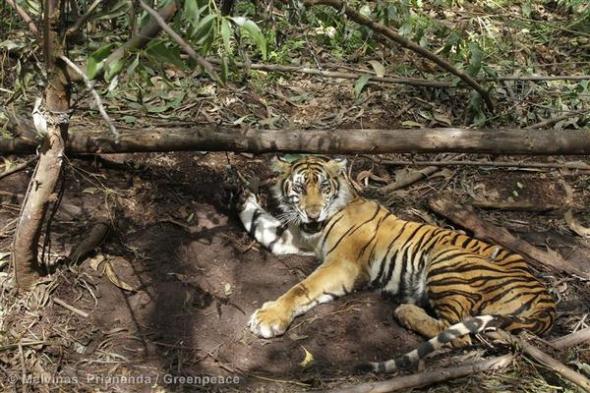
Sumatran and Bengal Tigers are regularly caught in snares and traps set by company paid locals to keep their workers safe that feed the American and European market with pulp, paper, palm oil and wood.
Tropospheric ozone harms living life forms, Ozone molecules in the troposphere damage lung tissues of animals and prevents plant respiration by blocking the openings in leaves, called stomata, where respiration occurs. Tropospheric ozone harms the plants that the prey of the Tiger feeds on thus decreasing again food intake, lack of sufficient prey food intake then kills or forces the animals out of their natural habitat.
Acid rain kills trees and harms animals to heavy industrialised acidic rain that is high in industrialised areas of the forests destroys the leaves of plants and trees without a doubt. When acid rain soaks into the ground, it can make the soil unhealthy for many living species including the Tiger species and its prey. Acid rain also changes the water in lakes and streams, harming fish and other aquatic life.
The short hand documentary shows what we have al known in the environmental world for many years, what is most concerning though is that there are more Tigers in American homes then there are “in the wild” at a rate of over 10,000 (estimate) The tropical pet trade must END now.
The Tiger species has a preference when hunting of which it hunts the Llamas a “type” Equine species however (not Equine related) that has more or less the same skeleton structure but very poor manoeuvrability in the dense jungles hence why the Tiger hunts the Ungulate species that’s relatively easily hunted that can keep a family of mother and cubs living for up to 3-4 days due to high contents of meat and meat saturation fat levels from the Llamas.
The Llamas feed on mainly grass, shrubs, and lichens. Lichens are earth’s first moss plants that grow on rocks and wood. Llamas are herbivores, so pollutants are a very big problem when they are destroying the Tigers natural habitat meaning its hunting grounds. The Tiger then has reduced prey as the Llamas are forced to move on to fresh pastures green which the Tiger cannot as living in such open areas that the Ungulates species can thrive in makes the Tiger more noticeable to its prey thus reducing natural predatory hunting.
Wild boar, buffalo, water buffalo, primates, hares, antelope and specie deer’s plus many more species that the Tiger “species” also hunt can and are effected by pollutants thus displacing the Tiger and it’s prey so yes indeed pollutants are a very big problem along with deforestation, and the humans massive demand for more “recyclable” products of which there is very little reusing and reducing evident in the modern world that we must ALL now start taking notice off.
Reported in this week’s weekend Leader 17th January 2013 and by WWF (World Wild Fund for nature) poaching of the Tiger species was said to have decreased, which is good news, or is it?
Sumatran and Bengal Tiger populations have decreased so dramatically that poachers simply cannot locate these beautiful kings of the jungle anymore which is good but sad news.
Taking a brief look into figures here and history we can see an awfully shocking trend that one must “not” just blame as quoted on the poacher. We all have to except the blame as explained above regarding pollutants, over commercialisation and obsessive consumerism.
The tiger population dropped over the past 100 years from an estimated 100,000 in the 1900’s to only 4000 in the 1970’s. A concerted effort by wildlife protection groups in the 1970’s halted their rapid demise and the global population of tigers in the wild has grown modestly to around 6000 at the turn of the century with great thanks to then Indian Prime minster that launched a massive operation to cease hunting that was being fronted by the illegal poaching industry, everyone breathed a sigh of relief as the Tiger population then shot back up which hadn’t the Indian president taken action then all Indian native Tigers would have been lost.
Poaching continues to this day though all over Asia and Russia, however. When a Russian poacher can make as much from a single tiger kill as he would normally earn in 6 years, it will take more than words to halt this tragedy it takes “skill and going back to our grass roots to understanding the Tiger and it’s preys natural habitat”. Only then can one preserve the Tiger species.
The range of tigers has changed over the past 100 years. Once roaming all throughout India, Southeast Asia they now only small live in pockets of small natural habitat. Law enforcement has not lowered poaching it’s unfortunately the massive declines in numbers of the Tiger species.
Quote
“In the 1970’s we came dangerously close to losing forever one of the world most magnificent creatures. Poaching, deforestation, and human expansion to pollution brought all species of tiger to the brink of extinction. Indeed, over the past centuries, 3 of the 8 sub-species that existed became extinct the Caspian, Javan and Balinese tigers. Today, we are by no means out of the woods. All remaining sub-species of tiger are endangered, making the tiger species as a whole nearly extinct”
The news report of which I have copied below from the Weekend leader wrote 17th January, quote;
In cheering news for wildlife conservationists, tiger poaching dropped nearly 60 per cent in 2011 as compared to the previous year, though it continues to pose a major threat to the survival of the big cat in the country, a leading NGO said. According to the Wildlife Protection Society of India (WPSI), 13 tigers were hunted last year as compared to 30 in 2010 - a decline of 57 per cent. The bodies of poached tigers, seized bones and skins were computed to arrive at the figures.
Adding other factors like road accidents, infighting, fighting with other animals, electrocution, found dead, and rescue and treatment, the overall toll rises to 61. In 2010, it was 58. However, top on the list of WPSI’s tiger mortality is the found dead figure, 21.
The toll from infighting was the same as that of poaching. In the previous year, 10 tigers died in such fights. “There has been definitely a decrease in poaching cases in 2011 compared to 2010, but it does not mean poaching has stopped,” said WPSI’s Tito Joseph. This could be “due to effective patrolling strategies adopted by the tiger authority (National Tiger Conservation Authority) in coordination with other agencies,” Joseph said. The illegal wildlife trade continues to be a major threat to tigers. Joseph said traders were offering huge amounts of money in black markets for tiger body parts.
“Recently trade activities were detected in Vietnam and Cambodia. The threat is not only from China (a known hub for such trade) but also from Southeast Asian countries,” he said. “We need to be vigilant 24 hours 365 days,” Joseph said. “Wildlife articles always have a very premium market and prices are not going to come down easily,” says U.C. Tiwari, wildlife warden of the Corbett National Park, Uttarakhand. The 1,200-plus sq km Corbett sanctuary is one of the 39 tiger reserves in the country.
The poaching figure only reflects the cases that come to light and it may not truly reflect the ground condition, said Tiwari. He warned that the situation could turn alarming if the mortality rate of adult tigers rises. “Because adult tigers don’t die easily… there has to be some extraordinary circumstance.” According to WPSI, of the 21 tigers found dead in 2011 many were adult tigers. In 2010, 15 tigers were found dead.
“The fact that many poachers are now lodged in jails has surely contributed to the decrease. They are still cooling their heels in different jails,” the official added. Acknowledging this, Ashok Kumar, an eminent tiger conservationist and vice chairman of the NGO Wildlife Trust of India, said poaching has reduced considerably as many poachers were jailed. “Our lawyers fight against them in court so they do not come out of jails.
“All Alwar (Rajasthan)-based poachers are today in jails,” said Kumar, referring to a gang blamed for extermination of tigers in the Sariska reserve, one of the two tiger sanctuaries in the state.
Kumar has been at the forefront of the fight against poachers and illegal trade of wildlife for over two decades. He was the first director of Traffic India, which studies wildlife trade.
Rajasthan is also home to the famed Ranthambore National Park. Sariska currently has five tigers, all shifted from Ranthambore as part of a government attempt to repopulate tigers in the reserve. The latest official tiger census report released in March 2011 estimated about 1,700 tigers in the country. – IANS
Reports for 2012 show other alarming figures though that pinpoint to “exactly what we have been informing the DEA South Africa of and India too” please read the link http://www.guardian.co.uk/environment/2012/aug/20/tiger-population-india-tourism-ban
The Rhinoceros in South Africa when we International Animal Rescue Foundation © started Operation Trojan Horse proved that “tourists where being watched to even “poachers” joining the damn tourists with no one law authority even aware of this.
These alarming finds were sent immediately to the DEA (Department of Environmental Affairs) South Africa and tour guides informing them to keep check of who is actually on their safari tour guides to entering South Africa.
India would ONLY do this IF they knew that poachers where becoming even more brazenly operational and daring by acting as tourists, then giving pin point geographical locations of Rhinoceros crashes hence we now believe 100% with evidence that we have, that the poacher is undertaking the same methods of infiltrating the South African tourists mobile travel safaris in South Africa as they are now in India.
We don’t believe that the poaching has decreased at all because of arrests made and increased patrols we believe that poaching has decreased simply because there are very few Tigers within the wild of which the Bengal and the Sumatran are the sought after Tigers. In an extracted article the following was quoted http://www.wtop.com/41/2968728/World-tiger-population-approaching-possible-extinction
Badaling Safari World - Beijing sell Tiger Bone within the zoo. It’s illegal hence why the permit states dispose of the bones and skin discretely so the government “know this” yet couldn’t care less.The investigation back from 2007-2008 by the EIA clearly shows the laws being broken. The Tigers do not die naturally they are staved to death hence why the large import and export of this illegal liquor, Some Tigers are kept back of which they are force breed. http://youtu.be/Rwv8mCw8JJs
“There are only 500 to 600 Sumatran tigers left in the world, so they hope to breed Kavi with one of the zoo’s youngest females. The zoo only has three Sumatran tigers right now.
In August of 2012 there was an exact number of one thousand Sumatran Tigers Panthera tigris sumatrae so since August and January 2013 “someone is not giving the correct figures out” We knew there was only 1000 left in the wild as of Greenpeace’s investigations into the Ramin tree, palm oil and pulp and paper trade.

On checking the full story in this zoo it was horrifying, these are protected and endangered species and this is how we treat them. The world has gone insane and sadly there are more zoos in Asia just like this.
With regards to the Bengal Tiger Panthera tigris there are literally 2,500 in the wild to date. The total number of Tigers in the wild that does not include the Siberian equals 3000 to 3100. The Siberian Tiger that’s critically endangered numbers at what some conservationists have quoted without taking into account scientific analysis is 500 – 600 however this is untrue.
Approximately 500 Amur tigers actually survive in the wild, but the effective population is a measure of the genetic diversity of the world’s largest cat. Very low diversity means any vulnerability to disease or rare genetic disorders are likely to be passed on to the next generation. So these results paint a grim picture for the tiger’s chance of survival.
“The findings are reported in the journal Mammalian Biology”
The Amur tiger, or Siberian tiger as it is also known, once lived across a large portion of northern China, the Korean peninsula, and the southernmost regions of eastern Russia. During the early 20th Century, the Amur tiger was almost driven to extinction, as expanding human settlements, habitat loss and poaching wiped out this biggest of cats from over 90% of its range.
By the 1940s, just 20 to 30 individuals survived in the wild. The new study has identified that this recent “genetic bottleneck” - when the breeding population of tigers was so critically low - has decimated the Amur tiger gene pool.
A more genetically diverse population of animals has a much better chance of survival; it is more likely, for example, to contain the genetic resistance to a variety of diseases and less likely to succumb to rare genetic disorders, which can be “cancelled out” by healthy genes.
Scientists in Russia, Spain and Germany worked together to analyse DNA samples from 15 wild Amur tigers in the Russian Far East. They took blood samples from the animals and screened them for certain “markers” - points in the DNA code that show that an animal had parents that were genetically very different from each other.
The results revealed evidence of the genetic bottleneck during the tigers’ recent history, when the variety of genes is being passed on dramatically reduced. Genetically speaking, the Amur tiger has not recovered from this. “Our results are the first to demonstrate a quite recent genetic bottleneck in Siberian tigers, a result that matches the well-documented severe demographic decline of the Siberian tiger population in the 1940s,” the researchers wrote in the paper.
“The worryingly low effective population size challenges the optimism for the recovery of the huge Siberian cat.”
Our total from number count of Tigers from scientific findings, investigations and worldwide knowledge estimates the entire Tiger species to now be under 3.400 and should pollution, obsessive consumerism, increasing commercialisation that increases climate change and impulse purchasing now not reside or drop then the tiger species coupled with poaching “will be extinct in two years or less” and that’s fact, along with that will then follow the Lion, Pangolin and the Rhinoceros species.
Bone wine trade and “skin or fur” trade is also a major benefactor that see’s the Tiger regrettably poached, Tigers are critically endangered and therefore non-tradable, the Asian government know damn well that Tigers are prohibited by International Union for Conservation of Nature laws from being moved or poached, CITES also prohibits such illegal activity of which traders to sellers MUST be shut down, fined and/or prosecuted. Such criminal activity is just ignored though and what part Asia actually play in helping to save any animal after viewing the EIA investigations in to blood ivory is still to be seen.
Be the voice - Help us to shut APP down, they are murderers and environmental desecration experts
Environmentalism 2013-2050 - Change or Suffer - Whats your new future resolution?
Environmentalism is a subject that today’s human must now start taking seriously with regards to climate change, over population, habitual destruction, pollution, deforestation, and veganism and vegetarianism, natural resource depletion, and habitat fragmentation.
Humans are not protecting Mother Nature enough within our society to date and although one can argue “I’m a vegan or I’m a vegetarian” so therefore I am saving the (world) that is complete and utter nonsense unless you’re also going to adopt the same methods as those that are trying to prevent man-made and natural environmental disasters.
Adopting a healthy vegan and vegetarian diet is roughly contributing to environmentalism by 0.001% unless you are prepared to cease the following main fundamental environmental destructive points listed below and take into account the alternatives as well as then consuming a healthy vegetarian and vegan diet.
Taking these methods on board would then increase one’s global welfare thus reducing your carbon output which in turn then adds up to reducing the damage we have contributed to global warming which unfortunately is now “climate change”.
What does one do to now cease climate change? Well you cannot cease climate change as the damage and destruction was clearly highlighted and done in the middle of the last century and increasing profusely in the 1980’s.
Climate change then increased dramatically rising air temperate, sea and river water levels to destructive weather patterns. So in reality it’s not what we do to cease this change it’s now adapting the change and slowing this destruction down.
The points listed below are just some of which you can adopt along with a healthy vegan and vegetarian life style of which your then contributing the earth and future generations vastly, through lowering hospital admissions, lowering the usage of synthetic medicines that are researched on animals, reducing cattle agricultural pollution, and more.
- Reducing fossil fuel usage such as, natural gas, coal, and oil.
- Reducing Carbon output by almost 80% or more such as automobiles, and heavy good’s vehicles.
- Recycling all waste including biodegradable waste.
- Reusing as much as possible such as plastic and paper carrier bags, bottles, containers, to clothes, bath water, school books and factory restored electrical equipment and more.
- Reducing our waste output, water output, chemical and electrical usage, paper, and wood.
- Adopting the use of more public transport, thus reducing carbon by even more.
- Using renewal energy.
- Reducing birth rates thus reducing over population.
- Purchasing “used” homes that have been fitted with renewable energy resources, (we don’t need to keep re-building if we reduce our birth rates and under age pregnancies)
- Adopting Eco cars that are powered on natural fuels such as “used” vegetable, and sun flower oil, to rape seed oil and now algae that’s still within the experimental stages but removes the usage of massive agricultural lands being used, loss of soil erosion, and reduced agricultural emissions from tractors, combine harvesters, and other machinery.
- Reduced home heat loss by 85% through insulating our homes.
- Learning to “ Eco drive” for example using the accelerator smoothly and progressively. Always avoid harsh acceleration. When you can, stop pressing down on the accelerator and let the momentum of the car take you forward. Travelling down a hill with your foot off the accelerator can save a considerable amount of fuel. Roof racks, bike carriers and roof boxes will affect your car’s aerodynamics and reduce fuel efficiency. If you have to use them make sure you remove them when not in use. Driving with the windows or sunroof open will also decrease your car’s aerodynamics.
- Reducing vehicle usage for example, if you live one or two miles from your place of work, or your children’s school is only one mile away then (WALK) your contributing to noise and air pollution which has a considerable effect on our botanical life to even increasing respiratory diseases of those that suffer from acute Asthma, Bronchopneumonia, Bronchitis and other lung infectious diseases to breathing problems within our younger and older generations.
- Ensuring that we use Eco friendly electrical equipment to its true potential for example a family sized refrigeration units needs to be kept full thus reducing more electrical usage that’s only freezing the air within and not empty space.
- Turing our electrical equipment of at night and not leaving it on standby, example a television, cooker, to the top of the range games consoles that now use massive quantities of power, they also “whilst on standby” are still using the same power plus more because it’s simply turned on in sleep mode generating “stored energy for next usage”.
- Rain water can be re-used to even sterilised to be used in cooking, watering the garden, to drinking or taking a shower, does that sound unhealthy and dirty to you? come back in 2100 and say that it’s dirty or view what our tribal elders do when they bathe you will be shocked at how non-dirty rain water is if you sterilize it.
- Cease the bath, and use the shower FACT - If your home was built before 1992, chances are your shower heads put out about five gallons of water per minute (gpm). Multiply this by the number of minutes you’re in the shower, and the water adds up fast. An average bath requires 30-50 gallons of water. The average shower of four minutes with an old shower head uses 20 gallons of water. With a low-flow shower head, only 10 gallons of water is used. Your PAYING HOW MUCH?
- Do we need to live in concrete homes? We can now actually live in completely environmentally friendly homes that are fitted with wind mills, solar panels, made from recycled materials, etc. Although this is an “extreme solution why are many people still ignoring this GREEN fact (please view the picture below) even top footballers are living in them
- Holiday locally and not abroad, of course one may wish to take the family car but did you know four people sharing a car would collectively be responsible for emitting only 104 kilograms of CO2, while the same four people taking up four seats on a plane would generate some 736 kilograms of carbon dioxide. FACT - Flying from San Francisco to Boston, for example, would generate some 1,300 kilograms of greenhouse gases per passenger each way, while driving would account for only 930 kilograms per vehicle. So, again, sharing the drive with one or more people would lower each individual’s carbon footprint from the experience accordingly. (please don’t hitch hike, its dangerous and can lead to your life being placed in danger)
- Purchase offsets which you can purchase here - http://environment.about.com/gi/o.htm?zi=1/XJ&zTi=1&sdn=environment&cdn=newsissues&tm=274&f=20&su=p284.13.342.ip_p504.6.342.ip_&tt=2&bt=1&bts=1&zu=http%3A//www.terrapass.com/ Consider purchasing carbon offsets to balance out the emissions you are generating with cash for renewable energy development. TerraPass, among others, makes it easy to calculate your carbon footprint based on how much you drive and fly (as well as home energy consumption), and then will sell you offsets accordingly. (Monies generated through carbon offsets fund alternative energy and other projects, such as wind farms, that will ultimately take a bite out of or eliminate greenhouse-gas emissions). :O) (smiley face, you got to love that one at least)
- Sustainable living from growing one’s own fruit and vegetables, nuts, seed’s, herbs to even tropical vegetables that can be germinated in a simple 8×12 glass house with fitted with ventilation, and green house heating and hot water tubing via the use of solar panels.
- Ceasing all palm oil including sustainable palm oil products that is found in 80-90% of all domestic and non-domestic products which would reduce deforestation greatly, illegal logging, river and sea bed pollution, and masses of carbon being released in to the environment from peat bed swamps that store all carbon output thus reducing massive plums of pollution released into the air. Stopping palm oil usage also reduces forest fires that are set to make way for palm oil plantations you’re also lowering inner city smog levels, and helping to preserve the natural fauna and flora such as the critically endangered Sumatran Tiger, Pygmy Elephant and Orang-utans. By cutting our palm oil intake we are also helping to conserve the green forest land and our natural medicines that are located deep within the heart of Brazil, Indonesia, Malaysia, Africa, Peru and the Americas. Cutting palm oil will also close down these colossal environmental abusive factories that are the size of 1000 soccer pitches.
Please read what this family created - http://www.telegraph.co.uk/earth/greenerliving/9032738/Build-eco-friendly-homes-and-save-money.html (there is no such word as cant in our eyes) The picture above is not linked to the link within. The picture above shows a typical ecological, environmentally safe home
Palm oil is not listed on my grocery shopping ingredients, how do I know if it contains palm oil?
Correct not all continents have yet adopted the rules which is confusing many people and concerning environmentalists, climatologists, scientists, vegans and vegetarians So we have listed the chemicals below that can be sourced in candy, crisps, cereal’s, to soap’s, shampoos, cooking oils to even tobacco.
Should you purchase any produce and wish to know if it contains palm oil then it will be listed in the ingredients panel as shown below. Please note these are just “some” and not all as palm oil is also mixed with many other ingredients from flavourings to preservatives and even car fuel.
Ingredients/chemicals that contain palm oil
Sodium Laureth Sulphate (can also be from coconut) Sodium Lauryl Sulphates (can also be from ricinus oil), Sodium dodecyl Sulphate (SDS or NaDS), Palmate, Palm Oil Kernel or Kernal, Palmitate Elaeis Guineensis, Glyceryl Stearate, Stearic Acid, Steareth -2, Steareth -20, Sodium Lauryl Sulphate Sodium lauryl sulfoacetate (coconut and/or palm), Hydrated palm glycerides, Sodium isostearoyl lactylaye, Cetyl palmitate (and anything with palmitate at the end)
These products are just some that contain (green) palm oil - There is no such thing as sustainable green palm oil (Green palm oil is just the same as non-green) - companies are just a little more (regulated) which means nothing it’s a sustainable LIE! RSPO need’s to now fine these companies that are breaking rules every day. Asia Pulp and Paper are one the largest offenders along with PT-KAL - Indonesia
Veganism and vegetarianism is not saving the world it’s just merely contributing to a healthy life style, reduced animal slaughter and abuse rate. Unless one adopts the above then we are all going to eventually see more destructive weather patterns like the floods of this year 2012 August to December, Typhoons, Hurricanes, landslides, soil erosion, repository borne infections from air pollution’s plus increased breathing problems.
Although this all well said and “written” it is actually harder to adopt these changes in an instance however there are many fundamental changes that can be changed almost instantly within the points listed, its more a case of have YOU got the willpower or are you PREPARED to see your children’s future and theirs a living misery?.
Weather patterns across this year for 2012 from the months of August to December and now as predicted from December 2012 to May 2013 have increased aggressively which is no thanks to everyone’s living life style whether it be vegan, vegetarian, or carnivore and the principals of how we live.
Over population, increased birth rates non-expected pregnancies, to habitual fragmentation, housing construction, deforestation and illegal logging, sea grass destruction, increased pollution rates, excessive vehicle usage to still not recycling in accordance with environmental laws of first world nations that are contributing to gargantuan overloads of carbon.
Carbon pollution is more evident within our botanical world today 2012 than it was fifty years ago within the 19th century, with browning and discoloration of leaves and stems in urban and now more rural districts, die back of sub shrubs and entire vegetable and cereal crops due to acidic rain pollution, soil erosion, flooding, to dust storms and intense summer heat climatological patterns to winter plants from the Narcissi, Anemones, Hellebore’s Forsythia, Snow Drop, to Verbena sprouting to flowering prematurely thus being killed off by any severe winter storms.
Dust storm - 2012 July - many more of these will be seen caused by over farming, drought, soil erosion, and weather fluctuations becoming more violent as predicted for 2050 - Phoenix, USA -
“
“July 24, 2012 – PHOENIX — A dust storm, or haboob, enveloped the greater Phoenix area in a cloud of yellow-gray blowing dust on Saturday night. The dust storms are becoming more frequent. For the second time since Saturday, a dust storm muscled its way into the Valley, just in time for the afternoon commute. National Weather Service meteorologist Charlotte Dewey said the storm was moving northwest and was first spotted between Eloy and Tucson. The dust storm covered cities in the metropolitan Phoenix area such as Scottsdale, Gilbert, Mesa, Apache Junction, Santan Valley, Chandler, Casa Grande and downtown Phoenix. There were no official estimates of its size, but Dewey says spotters estimated it was around 2,000 feet tall. She says there were also reports of 35 mph wind gusts in the area, and a report of a 50 mph gust at Phoenix Sky Harbor Airport. Above are photos of the event from The Associated Press and our iWitness Weather contributors. –KPHO“
It would be an advantage if one thousand people worldwide that read this within the winter went into their gardens and parks and documented on any plants that are growing prematurely so that we and other conservationists and botanists can gauge and assess how much more damage has been done to our sensitive horticultural world and climate to estimating climatological advances and temperature changes within the next fifty years to river level rise so that flood defenses barriers and better home construction to the correct education can be relayed to our younger generation thus helping our environment more as well as aiding environmental scientists and more.
http://www.epa.gov/apti/course422/apc1.html
Air pollution is one massive threat that still is not really recognised by international “governmental researchers” of which provide fundamental evidence for others to look into that’s rarely conveyed to the general public to the public not even noticing which if it did would increase alertness and awareness. to advanced weather warnings thus reducing casualties, land and home damage.
As the years passed, air pollution has got worse, and yet it was still not widely recognized as a threat to human health. Although there were some scientists and health professionals who recognized air pollution as a public health problem, most of the early control efforts were targeted at the aesthetic or welfare effects of air pollution. In the late 1800’s and early 1900’s, many smoke control ordinances were enacted in England and the United States. These laws were some of the first uniform statutes enacted for the control of air pollution. Our modern air pollution control program can be said to have evolved from these early ordinances.
The delay in recognizing air pollution as a health risk was partly a result of the nature of air pollution. Air pollution is usually not recognizable as is water pollution; therefore, it can be ignored as a health threat until the problem reaches crisis proportions. Air pollution episodes from the build-up of pollutants in the air influenced the development of air pollution programs in the United States.
March 2012 an international meeting of 154 nations took place regarding pollution levels of which scientists, climatologists, meteorologists and environmentalists explained in great detail by 2050 our planets sea level and environmental destruction is going to increase rapidly that has alarmed us and many other doctors and scientists.
More marine and fresh water fish are going to suffer and die along with waters contaminated as of large nuclear power plants still discharging masses of used hot water back into the river’s and seas, however the main concern highlighted is that of warmer summers and sea levels which regrettably the power plants are not going to able to discharge as much if any waters meaning our “air environment” will suffer greatly as the power plants will have to cool this used “nuclear water” within via other cooling processes of which is what one view’s the “clouds of steam” when travelling past these large chemical industrious chimney cooling plants, thus leading to more environmental warming. We are all to blame as we are using excessive amounts of electric and still not using the power given to us accordingly.
A warmer but more turbulent climate has been predicted that’s going to decrease our distribution networks along with warmer summers decreasing our efficiency with stormier weathers causing by far more destruction to our domestic and commercial properties.
Were all ready for the increase ? it’s happening already, problem is the arrogant push it to one side.
The EDF report then went on to quote “more customers have been using air conditioning units thus seeing more demand for electricity in the summer which in turn again increases climate destruction” The report then went on to quote “more electricity is being used in the summer via cooling, refrigeration units, showers, and air conditioning units which has NOW reversed the historical trend” that has worried ourselves International Animal Rescue Foundations Climate Research greatly and now needs to be addressed drastically.
The predictions for future energy demands and supply make for bleak reading: the world’s energy demands in 2050 are expected to increase by a further 80 per cent, and the OECD believes that 85 per cent of this energy will still be reliant on fossil fuel based energy. Renewables are forecasted to make up just 10 per cent and nuclear the remaining 5 per cent. All this could lead to a 50 per cent increase in greenhouse gas emissions and worsening air pollution, especially in built up urban areas.
Urban air pollution will become the top environmental cause of mortality worldwide by 2050, ahead of dirt water and lack of sanitation, the OECD said. The number of premature deaths from exposure to particulate air pollutants leading to respiratory failure could double from current levels to 3.6 million every year globally.
Worryingly, the global average temperature will exceed the internationally agreed warning limit. The OECD report stated that temperatures by 2100 will rise by 3 to 6 degrees Celsius, the globally agreed limit is 2 degrees Celsius. This will be due to the continued reliance on fossil fuels, which will cause carbon dioxide emissions from energy use to grow by 70 per cent.
On land, the OECD forecasts global biodiversity to decline by a further 10 per cent, with significant losses in Asia, Europe and Southern Africa. Areas of mature forests are projected to shrink by 13 per cent. About one-third of biodiversity in rivers and lakes worldwide has already been lost, and further losses are projected to 2050. Yet despite this, the report adds that global water demand will increase by some 55 per cent, due to growing demand from manufacturing, thermal power plants and rising domestic use.
These projections highlight the urgent need for new thinking, says OECD Secretary-General Angel Gurría.
“We have already witnessed the collapse of some fisheries due to overfishing, with significant impacts on coastal communities, and severe water shortages are a looming threat to agriculture,” said Gurría.
“These enormous environmental challenges cannot be addressed in isolation. They must be managed in the context of other global challenges, such as food and energy security, and poverty alleviation.”
To avert the grim future painted by the Environmental Outlook to 2050, the report recommends a cocktail of policy solutions; including using environmental taxes and emissions trading schemes to make pollution more costly than greener alternatives; valuing and pricing natural assets and ecosystem services like clean air, water and biodiversity for their true worth; removing environmentally harmful subsidies to fossil fuels or wasteful irrigation schemes; and encouraging green innovation by making polluting production and consumption modes more expensive while providing public support for basic R&D.
International Animal Rescue Foundations staff and board of directors are all vegetarians and vegans, although it’s seen as positive to outline the importance and advantages of a healthy vegan and vegetarian diet it must be seen within our mission statement to that environmentalism and climatology is top and main priority over everything with healthy eating seen as the not so top importance of to do lists.
http://www.climateactionprogramme.org/news/pollution_levels_set_to_double_unless_action_is_taken_warns_oecd/
We either change now and take notice of the drastic effects that we are causing to the environment that includes “everyone” or we just give up. Vegan and vegetarianism doesn’t save the planet FACT, nor does it make it a much better place for us all to live in. YOU save this planet by not just adopting a “healthy eating programme” but “addressing the main fundamental environmental points around us”
Calculate your carbon footprint here http://environment.about.com/gi/o.htm?zi=1/XJ&zTi=1&sdn=environment&cdn=newsissues&tm=274&f=20&su=p284.13.342.ip_p504.6.342.ip_&tt=2&bt=1&bts=1&zu=http%3A//www.terrapass.com/
Ignorance will only see our children suffer more - You are that ignorant individual if you carry on abusing the environment
http://www.bbc.co.uk/news/world-south-asia-10903426
YOUR CALL 2050 BUCK UP OR IGNORE
Solar storms and how they effect the earths weather system - heliophysics
Written by Dr J C Dimetri V.M.D, B.E.S, Ma, PhD , MEnvSc
Botanical Activism - Be the CHANGE you want to SEE in this world
A topic that we don’t normal speak about is botany Botanical conservation preservation is one of the most highly important subjects that actually goes amiss on many conversational pages to conferences internationally which is rarely spoken about in vast detail.
HISTORY IN BRIEF
Botanical conservation is just as important as mammal and non-mammal conservation which is being destroyed by habitual destruction, over population, pollution, and logging on a daily basis at a gargantuan level which is concerning ourselves from which we have our own botanical welfare unit that trained at Writtle College in London, Essex United Kingdom where most to many famous botanists trained that now help to preserve our delicate species of plant life globally.
Carl Von Linnaeus - http://en.wikipedia.org/wiki/Carl_Linnaeus although didn’t train at Writtle educated many botanical conservationists in the 1700’s on a great deal of knowledge within the plant and arboretum world.
Professor Linnaeus then went on to classify each individual plant with what we now know as the “generically bionomical naming system that’s used to identify one singular family of “plant” as in “species” to “genus” then X or “cultivar” for example a simple Birch tree to you would just be that!. Professor Carl Von Linnaeus changed this naming “the incorrect common naming system that misidentifies many plants to the human eye” of which the Birch is and should be named as Betula.
Carl Linnaeus was an 18th Century scientist who is considered the father of modern taxonomy, the classification of organisms.
The naming system goes in to great detail though in pure Latin that would then again for example rename the common Birch down to what its appearances was, so those that see little girl wigs on the end of Birch’s budding deciduous stems would then explain to us that we was not just looking at a Birch but in fact a Betula pendula that’s height is roughly forty foot is deciduous and has the most beautiful pendulating stems an “almost entire correct classification of one singular species of tree in one simple name”. The same generically naming system is also used within medicine, mammal and non-mammal identification.
HOW IMPORTANT IS OUR BOTANICAL WORLD THOUGH?
Botanical horticulture to arable agriculture and forestry management is extremely important, and without small shrubs, trees to medicinal plants and vegetables then we the human race would not be able to survive on today’s copiously destructive planet, and that is regrettably a misfortunate fact of life.
Plant life is used for many things that you the human aren’t even aware of, from non-synthetic medicines and synthetic medicines to boost the power of the active properties, to vegetables, rape seed fuel to palm oil that’s now being grossly used en-masse which is seeing vast amounts of plantations planted ripping up many medicinal plants, displacing Orang-utans, to filling our environments sensitive atmosphere with humungous amounts of carbon from the agitated peat swamps.
See more here. http://www.greenpeace.org/international/en/publications/reports/palmoilexpansion/ the palm oil tree is indeed a spectacular plant http://en.wikipedia.org/wiki/Elaeis however it’s being over exploited as it possess “gold” and unfortunately in today’s society where there is money there is happiness even if its destroying our precious Orang-utans and their environment along with the Sumatran Tiger and Ramin Tree http://en.wikipedia.org/wiki/Gonystylus
We don’t just rely on plants such as vegetable crop to keep us alive we actually require them for natural medicines that are found mostly in the tropical rain forests of Brazil, Asia, Africa and the Americas from which habitual destruction from logging, pulp and paper trade is playing a vast role in the catastrophic destruction of our medicinal plant life.
http://www.scientistlive.com/European-Science-News/Dentistry/Rainforest_remedy_could_spell_end_of_dental_pain/25473/
Many narcotic cartels also work within these heavy foliaged forests that is also a underlying problem which see’s many opium and Marijuana crops grown on a massive scale http://www.drug-aware.com/articles/157/cocaine-and-the-destruction-of-the-rainforests/ although narcotic units are trying their hardest to break these plantations down what they seem to forget is when destroying them on locating such criminal forestry networks they simply set them ablaze killing surrounding plant life thus making that singular or group of very important plants life harder to then spread their seed’s and/or pollenate.
Cities and vast populated areas need green life to, to clean the air from exhaust fumes that build up within inner city limits and sprawling urban districts. You may think that when you drive your vehicle in to the local town or city that you’re doing your legs good however you’re making the surrounding trees and plant life’s a living misery even if your car is fitted with a catalytic converter.
You can see some of the impact of air pollution botanical species when you look at damaged plants. Pollution enters the plant and oxidizes its tissues, leading to discolored leaves and speckled leaves that often look like they are burned or bleached.
Less visible but still important is the fact that plants grown in polluted areas have fewer leaves and a smaller root system than do plants with healthy air. They also have reduced yields and often drop their leaves earlier in the season than healthier plants and tress do.
Air pollution from carbon output is more than evident on this Spruce that will eventually die
Similar problems can be caused by soot and other air pollution problems, not to mention the unpleasant aspects of gardening in polluted air from the gardener’s point of view.
Plants that are sensitive to this type of pollution are listed here below I have included only the common names so one can familiarise oneself with these plants and know what to grow and not what to grow on urban city limits.
- Red and speckled alders
- Groundnut
- Dogbane and spreading dogbane
- Mugwort
- Tall, swamp and common milkweed
- Redbud
- American hazelnut
- Green and white ash
- Black huckleberry
- Sweet Gum
- Evening primrose
- Virginia creeper
- Sweet mock orange
- Ponderosa, Pacific, Jack, Jeffrey, Monterrey, Loblolly and Virginia pines
- American sycamore
- Black cherry
- Allegheny, thorn less and sand blackberries
- Sassafras
- Goldenrod
- Huckleberry
- Northern fox and European wine grapes and
- Buckeye
Plants that are pollutant lovers and will consume it then spit it back out I have listed below in brief detail using the generically listed naming system.
- Amelanchier Canadensis
- Aucuba japonica
- Berberis
- Ligustrum ovalifolium
- Olearia haastii or Osmanthus burkwoodii
- Syringa vulgaris
- Tamarix tetrandra
- Weigela florida
Madagascar Periwinkle is located in many arid Rain Forests - Used to fight Malaria which is sadly being destroyed at an ever increasing rate by illegal logging and the paper and pulp trade.
Plant life though is not just used by us for keeping out chemical pollution’s they are also ideal for noise and wind breaks. Noise pollution’s I shall detail more of rather than that of wind breaks of which you can read more on here - http://www.extension.umn.edu/agroforestry/components/selecting-trees-and-shrubs-in-windbreaks.pdf
Noise pollution kills much wildlife and can interfere to with our way of life vastly thus pushing us in to rural areas. Many cities to new apartment blocks and factories contain at least some species of tree life that help to filter out noise pollution which does have a considerable impact on one’s health.
Noise pollution affects everyone, yet this problem is largely ignored by most people. Upon hearing loud noises and sounds, we might be irritated but feel at a loss to do anything about it. Noise pollution comes from various sources including traffic, airports, industries, factories and highly populated urban areas. However, these are not the only ways we can be affected by noise pollution. A loud musical event such as a rock concert, occupational noises, and large crowds are just as detrimental to humans, especially with repeated exposure.
The effects of noise pollution on humans are being studied all over the world. The U.S. Environmental Protection Agency recommends a “safe noise level” of no more than 55 decibels. Decibels are units that help to express how loud sounds are. For example, sounds that are inaudible range from 0 to 10 decibels; noises that are loud enough to damage your hearing are 150 decibels.
Noise pollution affects sleep, eating habits, mood, concentration and body functions such as respiration and heart rate. When humans are unable to sleep due to noise, they get insomnia. Insomnia causes mood swings and can affect performance in all areas of your life, as well as negatively affect your health.
Loud noises cause stress, increasing respiration and heart rate. Then your body begins to secrete hormones such as adrenaline, which prepare us for fight or flight. This response puts unnecessary stress on the body.
As a result, your blood pressure increases, leaving you vulnerable to heart disease. Stress also contributes to lowered immunity, which can lead to infection and illness. Some scientists are now suggesting that psychiatric disorders are related to noise. This theory is still under investigation and is highly controversial.
The most significant way that people are affected by noise is through hearing loss. This is easy to measure and widely studied. It is known that young people today experience hearing loss at early ages because of the loud music they listen to while wearing headphones and attending concerts. Therefore, teenagers are likely to hear 25 per cent less than their parents or grandparents do.
The effects of noise pollution are also relevant to each individual. Some people are not bothered by particular sounds as much as others might be. This is because some are more sensitive to auditory stimulation. It is not understood why certain people become more aggressive when exposed to loud noises, but it probably has to do with how much noise you are used to hearing. For example, a rural dweller who is used to the quiet sounds of nature would probably be agitated if he to spend the night in a city.
The EPA regulates businesses and areas for noise pollution. However, there are ways that you can control your environment. Noise-blocking devices such as earplugs and headphones cut out sounds that may affect your sleep, work or personal time. You can also buy CDs that play monotone- or nature-type sounds and use this as soothing background music. Another way to reduce noise is to get involved with local organizations that shape new business development and regulate present industries and noise problems in your area.
THIS IS WHY MANY TRES’S ARE PLANTED IN URBAN DISTRICTS – SADLY NOT ENOUGH AS MUCH NOISE IS STILL HEARD YET COUNCILS DO NOTHING!
OUR BOTANICAL LIFE IS EVEN MORE IMPORTANT THAN YOU THINK
The Taxus-baccata is actually used to treat breast cancer - and is one of the most powerful anti-cancer NATURAL medicines on the earth to date. The Taxus or common English Yew is used now daily in fighting cancer FACT.
PLEASE don’t try to make any medicines from the Taxus yourselves to even digesting it, it’s also one of the most poisonous plants in Europe and it’s berries are highly toxic.
May Flower, Yellow birch, Sweet fern, Pink ladies slipper, Indian pipe, are just some of the thousands of plants that occupy our planet that simply go amiss or are not really noticed by the busy human.
The more we kill of plant life the more natural medicines become harder to find. Hypericum vulgaris http://www1.agric.gov.ab.ca/$department/deptdocs.nsf/all/prm13955 is in fact used as a natural prescription anti – depressant that’s used by millions of citizens internationally.
The Hypericum vulgaris is widely used as an anti-depressant all over the European Union yet we call it a WEED?
Should man continue to wreak havoc in the jungles destroying our most sensitive species of medicinal botanical life then more vivisection and medical animal research will be needed to sustain “ man-made synthetic medicines”, as we are more than aware of the usage of plants and their dangers to qualities to that of man-made medicines that are tested on many animals from canines, felines, primates, equestrian species, pigs and more.
We are concerned at the high destruction rate of our rain forests a day that hold many species of medicinal plants and trees, every seven days in the Malaysian, Indonesian and Brazilian Rain Forests there is in length a total for that seven days of destruction roughly 2,520 feet of forest land felled taking with it many species of plant life and mammal life to. That is roughly 131.400 feet in length a year which doesn’t include the full square width which is just under that total.
“Your paper, wood, KFC, McDonald’s Burger King paper, wrappers, and more, to fuel come from forests such as this wiped out for YOU! killing many plants and tress that then aids more vivisection and animal medical research, we plants and trees that we need to sustain our medical world yet your wiping them out?”.
By the year 2020 we will view a whopping 80% of our delicate green forest and plant life wiped out just for human usage. Newspapers, fast food outlets, the timber trade, palm oil, fuel trade and printers are all to blame yet we sit back and do nothing and still allow this destruction to go on daily.
Cinchona Tree: This tree is found in the Latin American and African rainforest and prominently figures in the list of rainforest plants used for medicine. An alkaloid, Quinine is extracted from the bark of the tree and is used to cure malaria.
Curare Lianas: This large poisonous vine is full of alkaloids used for treating bruises, fever, oedema and kidney stones. As it also helps to relax muscles, and thus, is used as an anaesthetic agent.
Saw Palmetto: Extracts from Saw Palmetto’s berries is used to treat certain urinary problems. This was first used by people in Florida. The fruit contains 5-alpha reducers that inhibit the production of prostaglandins (related to prostatic treatment).
Wild Yams: Extract of the tubers of Dioscorea wild yam, diosgenin is an active ingredient used in birth control pills. It is also used in many steroidal products like pregnenolone, progesterone, etc.
Trumpet Tree: A popular medicinal tree used extensively in traditional medicine in Central and South America. All parts of the tree; leaves, fruits, flowers, bark and roots are used to treat respiratory illnesses and rheumatism.
Pacific Bleeding Heart: This delicate plant comes from the forests of the Pacific Northwest. Tincture is extracted from its roots and used to provide relief from external bruises and sprains, and when taken internally, it is known to sooth frayed nerves.
Cocoa Tree: The cocoa tree is one of the few trees that is extremely high in medicinal value, thus, making it one of the most important medicinal rainforest plants. This one tree alone produces over 150 chemicals that can be extracted from its leaves, seeds, fruit and bark. The extracts are used to treat anxiety, fatigue, fever, coughs, kidney stones, and external cuts and bruises.
Clavillia: This perennial herb contains vital active compounds like proteins, triterpenes, flavonoids, alkaloids, etc. used to treat infections caused by viruses, bacteria, fungi and parasites.
Mammosa: Member of the eggplant family, mammosa is used to treat sinus infections, and lesions caused by various skin cancers.
Periwinkle: Extracts of the periwinkle plant have two of the most active tumour fighting agents. It is used widely and very successfully in treating leukaemia and Hodgkin’s disease.
Sorosi: Sorosi is a vine whose extract is used to treat ticks or lice when used externally, and is used as an internal remedy for treating delayed or painful menstruation, and dysentery.
Lemongrass: Lemongrass has antibacterial and antifungal properties which aid is treating fevers, colds, and coughs. Lemon grass tea is a very popular herbal tea.
Annatto Tree: Oil extract of the Annatto tree contains carotenoids bixin, used for protection against UV rays. It also helps to lower blood pressure and serves as a powerful insect repellent
Despite the role they play in ensuring a healthy life for us, humans have shown a complete disregard to rainforests around the world. Today, less than 5% of the earth’s surface is covered with these forests. With the number of ever-increasing diseases and infections that are now prevalent among us, rainforest plants used for medicines are more needed than ever. Hence, it is up to us, to save the rainforests from turning into barren land.
FACT
Approximately 7,000 medical compounds prescribed by Western doctors are derived from plants. These drugs had an estimated retail value of US$43 billion in 1985. Seventy per cent of the 3000 plants identified by the United States National Cancer Institute as having potential anti-cancer properties are endemic to the rainforest. Tropical forest species serve Western surgery and internal medicine in three ways. First, extracts from organisms can be used directly as drugs. For maladies ranging from nagging headaches to lethal contagions such as malaria, rainforest medicines have provided modern society with a variety of cures and pain relievers.
We are all up for saving ANIMALS and HIGHLIGHTING the gruesome vivisectionists cruel and barbaric science however WE NEED TO STOP! THINK! And LOOK AROUND! And ask ourselves why the hell they are still using animals to such a great extent. SIMPLE because we are not paying enough attention to the rain forests and plant life within from which many of our plants provide much needed medicines for us.
Of course one has to remember to that the selfish human smokes, drinks and consumes fatty foods thus pushing hypertension up and tachycardia down, strokes, cardiac arrest, and much more of which our medicines are growing use to us which in turn means “more medicine research = more animals murdered worldwide every year!. I am sure it doesn’t take a genius to work that out.
The more we ignore this blatantly obvious fact of life the more were going to fight a losing battle against the vivisectionist’s and animal research experimental science. Please note that this does not include “actual research for neuron-degenerative diseases to birth defects, blindness and psychiatric illness which is by far more complex. This research will continue to go on as it’s not “inflicted” (as such) (it’s inherited by genes).
FACT
It is estimated by the World Health Organization that approximately 75-80% of the world’s population uses plant medicines either in part or entirely. For many this is out of necessity, since many cannot afford the high costs of synthetic pharmaceutical drugs. Growing numbers of American health care consumers are turning to plant medicines for many reasons - low cost and seeking natural alternatives with fewer side effects are commonly cited.
FACT
Synthetic medications provide by far 80% MORE side effects than that of natural herbal medicines used within the homeopathy trade or used as natural medicines.
Startling but true and yet we simply allow it to go on daily without cutting down our usage of paper materials, wood, or fast food waste. Reuse, Reduce, and Recycle are our three main important missions statements that we the International Animal Rescue Foundation © highlight every day, and by simply adopting these most significantly important roles of life then we will reduce the destruction of our medicinal plant world, tropical rain forests to mammal life destruction and extinction to plus reducing our CARBON FOOT PRINT = reduced climate change.
Dr Joseph Claude Dimetri Chief Executive Officer, BVetMed, MSc, MEnvSc, PhD, Ba
“WE ARE ALL ONE - IF WE CONTINUE TO KILL OUR EARTH THEN OUR CHILDREN HAVE NO NOTHING TO FIGHT FOR. THE BEST CHRISTMAS PRESENT YOU CAN GIVE TO YOUR CHILDREN IS CONSERVATION EDUCATION PRESERVATION AND NOT VIOLENT ACTIVISM”






